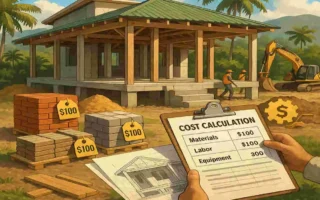Have you ever wondered what goes into building a house that stands the test of time? Home construction is more than just hammering nails and pouring concrete—it’s the backbone of creating safe, comfortable living spaces. Whether you’re a first-time homebuyer dreaming of your perfect nest, a builder looking to refine your skills, or a homeowner planning a renovation, understanding the different types of house construction can make all the difference.
Think about it: the way a house is built affects everything from its durability against harsh weather to how much you’ll spend on energy bills. Home construction involves selecting the right building materials and construction methods to match your needs, budget, and location. It’s not just about aesthetics; it’s about creating a home that feels right for you and lasts for generations.
In this article, we’ll dive deep into the world of residential construction. We’ll start with the basics of what home construction really means, then explore traditional, modern, and specialised types of house construction. By the end, you’ll have a clear picture of options like wood frame homes, modular builds, and eco-friendly techniques. Please stick with me, and let’s uncover how these choices can shape your dream home. What type do you think might suit your lifestyle best?
As we go along, I’ll break things down step by step. We’ll look at pros, cons, and real-world examples to help you decide. If you’re in the market for home building, this guide will empower you to make informed choices. Ready to build your knowledge? Let’s get started!
What is Home Construction?
At its core, home construction is the process of turning a blueprint into a livable structure. It starts with an idea—a vision of your ideal home—and ends with a finished building ready for you to move in. But what does that really involve? Imagine gathering building materials, assembling a team of workers, and following a step-by-step plan to create walls, roofs, and everything in between.
The construction process kicks off with planning. You sketch designs, get permits, and choose a site. Then comes the foundation work, where builders dig and pour the base to support the entire house. From there, they erect the frame, add walls, install plumbing and electrical systems, and finish with roofing, painting, and interior touches. It’s like piecing together a giant puzzle, and each step ensures the home is sturdy and functional.
Several factors influence which type of house construction you pick. Budget plays a huge role—some methods are cheaper upfront but cost more in maintenance. Climate matters too; homes in rainy areas might need water-resistant building materials, while those in earthquake-prone zones require flexible structures. Local regulations often dictate what’s allowed, and don’t forget aesthetics—do you want a cosy cabin feel or a sleek modern look?
Choosing the correct construction method is crucial for durability. A well-built home withstands storms, pests, and time, keeping you safe and comfortable. It also affects costs: energy-efficient builds save on utilities, while durable ones reduce repair bills. Plus, the right choice boosts your home’s value. Ask yourself: What does your dream home need to endure? By understanding these basics, you set the stage for a successful home-building project.
You may also read (edgeland house a sustainable living experience in texas).
In short, home construction isn’t just about erecting walls—it’s about crafting a space that fits your life. Whether you’re building from scratch or remodelling, knowing the process helps you avoid pitfalls and enjoy the results.
Types of House Construction Overview

Before we dive into the details, let’s get a quick bird’s-eye view of the main types of house construction. These construction methods range from time-tested classics to cutting-edge innovations, each with unique strengths for different needs.
Here’s a brief bulleted list of the key ones we’ll cover:
- Traditional types: Like wood frame, brick and block, and concrete—reliable standbys for everyday homes.
- Modern and alternative methods: Including steel frames, modular homes, insulated concrete forms (ICF), and structural insulated panels (SIPs)—perfect for efficiency and speed.
- Specialised and regional options: Such as adobe, log homes, and green techniques—ideal for eco-conscious or location-specific builds.
This overview sets the stage for our deeper exploration. Each type has its place in residential construction, depending on your goals. Which one catches your eye first? Let’s break them down one by one.
Traditional Home Construction Types
Traditional types of house construction have been around for centuries, forming the foundation of many neighbourhoods. These methods use familiar building materials like wood, brick, and concrete, offering tried-and-true reliability. Builders love them for their straightforward approach, but they come with trade-offs. Let’s explore three popular ones in detail.
Wood Frame Construction
Wood frame construction is one of the most common construction methods in home building, especially in North America. Picture a skeleton of wooden beams and studs forming the structure—it’s like building with giant Lincoln Logs. This technique dates back to the 19th century, when lumber became widely available, revolutionising residential construction.
The materials are simple: think softwoods like pine or fir for the frame, plywood for sheathing, and insulation stuffed between the studs. Builders nail it all together, add drywall inside, and siding outside. It’s flexible, allowing for easy modifications during the build.
One significant advantage is cost-effectiveness. Wood is affordable and abundant, making this a budget-friendly choice for many families. Plus, it’s flexible— you can easily add rooms or change layouts. Homes built this way go up quickly, often in months rather than years.
But there are downsides. Wood is vulnerable to pests like termites, which can chew through your investment if not treated. Fire risk is another concern; wood burns easily, so fireproofing is essential. In humid areas, rot can set in without proper sealing.
This type thrives in regions such as the U.S. suburbs or Canada, where timber is abundant. If you’re in a mild climate, a wood frame might be your go-to. Have you seen those charming suburban houses? Many owe their existence to this method.
Brick and Block Construction
Moving to something sturdier, brick and block construction uses solid masonry for walls. Bricks are baked clay rectangles, while hollow blocks are concrete units filled with rebar for strength. This type of house construction has roots in ancient times, from Roman villas to modern townhouses.
Builders stack these materials with mortar, creating thick, load-bearing walls. It’s a hands-on process that requires skilled masons to ensure everything aligns perfectly.
The benefits are impressive. Durability tops the list—brick homes withstand wind, rain, and time like champions. They’re also fire-resistant, giving you peace of mind during emergencies. Energy-wise, the thermal mass keeps interiors cool in summer and warm in winter.
On the flip side, costs can climb. Materials and labour aren’t cheap, and building takes longer—sometimes twice as long as wood frames. It’s also heavier, requiring a strong foundation.
You’ll spot these in places like the UK or older U.S. cities, think red-brick row houses in Boston. If longevity is your priority, this could be ideal. What do you think—would a brick home suit your neighbourhood?
Concrete Construction
Concrete House construction brings industrial strength to home building. It comes in forms like poured concrete walls, where liquid mix hardens in place, or precast panels assembled on-site like giant Lego pieces.
This method gained popularity in the 20th century for its robustness. Materials include cement, sand, gravel, and reinforcements like steel bars.
Pros include unmatched strength—perfect for high-wind or seismic areas. It’s also energy-efficient, with excellent insulation properties that reduce heating costs. Concrete resists fire, pests, and rot, making it low-maintenance.
However, it’s pricey upfront due to the specialised equipment and skilled labour required. The process can be messy and time-consuming, with curing times delaying move-in.
It’s common in apartments, modern homes, or regions like Florida prone to hurricanes. Imagine a sleek concrete bungalow—durable and stylish. Is this the challenging build you’re after?
Modern and Alternative Construction Methods

As technology advances, home construction evolves with innovative construction methods that prioritise speed, efficiency, and sustainability. These alternatives challenge traditional builds, offering fresh options for today’s homeowners. Let’s unpack four key ones.
To help you compare, here’s a simple table summarising their key features:
Construction Method Key Advantage Main Drawback Typical Cost Range
Steel Frame High strength Thermal conductivity Medium-High
Modular/Prefab Fast assembly Limited customisation Low-Medium
ICF Excellent insulation , Higher material costs , Medium-High
SIPs Quick build time Vulnerability to moisture Medium
This table gives you a quick snapshot—now, let’s dive deeper.
Steel Frame Construction
Steel frame construction swaps wood for metal beams, creating a skeleton of durable steel. It’s like upgrading from a wooden toy to a metal fortress in residential construction.
The process involves welding or bolting steel components, often coated to prevent rust. It’s precise, with frames fabricated off-site for accuracy.
Advantages shine through: steel is robust, resisting earthquakes and heavy loads. It’s pest-proof—no termites here—and fire-resistant, a big plus for safety. Builds are faster once the frame is up.
Limitations include thermal conductivity; steel can make homes feel colder without extra insulation. Costs are higher than wood, and you need experts for installation.
It’s popular in urban high-rises or modern homes in Australia. If you want a resilient structure, steel might appeal. How does that sound for your next project?
Modular and Prefabricated Homes
Modular homes are built in factories as sections, then transported and assembled on-site. Prefab is similar but includes more pre-made parts. This type of house construction streamlines home building like an assembly line.
The process is efficient: design, factory build, ship, and connect utilities. It’s quick—homes can be ready in weeks.
Benefits include cost savings from mass production and less waste. Speed is a game-changer for busy families, and quality control is top-notch in controlled environments.
Downsides? Customisation is limited; you pick from templates. Transport can be challenging in remote areas, and some consider them less “premium.”
Trends indicate a rising popularity in Europe and the U.S., accompanied by affordable housing booms. Imagine snapping together your home—exciting, right?
Insulated Concrete Forms (ICF)
ICF uses foam blocks filled with concrete, creating insulated walls. It’s a clever twist on concrete construction methods.
You stack the forms, pour concrete inside, and voilà—strong, energy-saving walls.
Thermal benefits are enormous: superior insulation slashes energy bills. Structurally, it’s tough against disasters.
Suitability? Great for cold climates, but costs more due to specialised forms. Installation needs pros.
It’s gaining traction in energy-conscious builds. Ready to go green and strong?
Structural Insulated Panels (SIPs)
SIPs are sandwich-like panels with a foam core between rigid boards, used for walls and roofs.
They work by locking together to form airtight structures, speeding up the building process.
Advantages: excellent energy efficiency and fast assembly—cut build time by half.
Drawbacks: moisture can damage if not sealed, and upfront costs vary.
They’re ideal for modern, eco homes. What efficiencies could SIPs bring to your build?
Specialised and Regional Construction Types
Not every home fits the standard mould—some types of house construction draw from regional traditions or eco-innovations. These specialised methods cater to unique environments or values, blending traditional wisdom with innovative ideas. Let’s explore three fascinating ones.
Adobe and Earthen Homes
Adobe construction uses sun-dried mud bricks, a technique from ancient Southwest U.S. and Mexico. Earthen homes expand this with natural soil mixes.
It’s eco-friendly, utilising local earth to minimise transportation emissions. Walls regulate temperature naturally.
Benefits include low cost and sustainability—perfect for green living.
Challenges? Vulnerability to water damage in wet areas and labour-intensive builds.
Popular in arid regions like New Mexico. If you’re earth-conscious, this could ground your home—literally!
Log Homes and Timber Construction
Log homes stack whole logs horizontally, creating rustic cabins. Timber construction uses large beams for a similar vibe.
Characteristics include natural insulation and a cosy, wooded aesthetic. It’s appealing for its timeless charm.
Limitations: logs settle over time, needing maintenance, and they’re prone to pests.
Common in forested areas like Scandinavia or the U.S. Rockies. Dreaming of a cabin retreat? This might be it.
Green and Sustainable Construction Techniques
Green construction methods focus on eco-friendliness, like straw bale walls (baled straw plastered over) or rammed earth (compacted soil).
Examples include the use of recycled materials in buildings, which helps reduce waste.
Demand is soaring as people prioritise the planet—benefits like lower carbon footprints and healthier living.
Market trends show growth in sustainable home building. Join the green revolution—what sustainable twist would you add?
Factors to Consider When Choosing a Home Construction Type
Picking the correct type of house construction isn’t a snap decision—several factors come into play. Let’s break them down so you can weigh your options.
Climate and environment top the list. In hot areas, choose materials that stay cool; in cold ones, prioritise insulation. Also consider local hazards such as floods or earthquakes.
Budget matters—factor in upfront costs versus long-term savings. Some methods save money now but incur higher costs later in maintenance.
Construction time and labour: Need it fast? Go modular—availability of skilled workers in your area counts.
Here’s a quick bulleted list of maintenance needs to consider:
- Wood: Regular pest checks and painting.
- Concrete: Minimal, but crack repairs.
- Green methods: Eco-friendly but may need natural treatments.
Resale value ties into trends—energy-efficient homes sell faster. What factors resonate with you?
How the Choice of Construction Type Affects Homeowners
Your home construction choice ripples through daily life. Energy efficiency, for instance, directly hits utility bills—insulated types like ICF can slash costs by 20-30%.
Durability ensures safety; steel frames weather storms better, giving you security.
Comfort varies: wood feels warm and inviting, while concrete offers quiet stability. Aesthetics shape your home’s vibe—rustic logs versus sleek modular.
Insurance rates drop for fire-resistant builds, and property values rise with sustainable features. How might your choice enhance your lifestyle?
You may also read (castle house st george utah utahs stunning modern day european castle).




